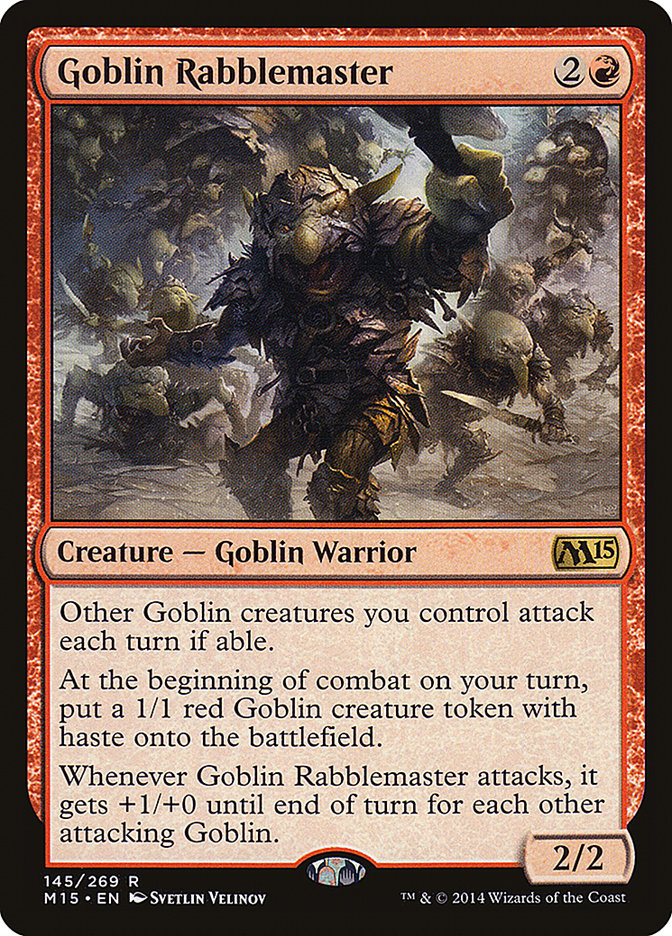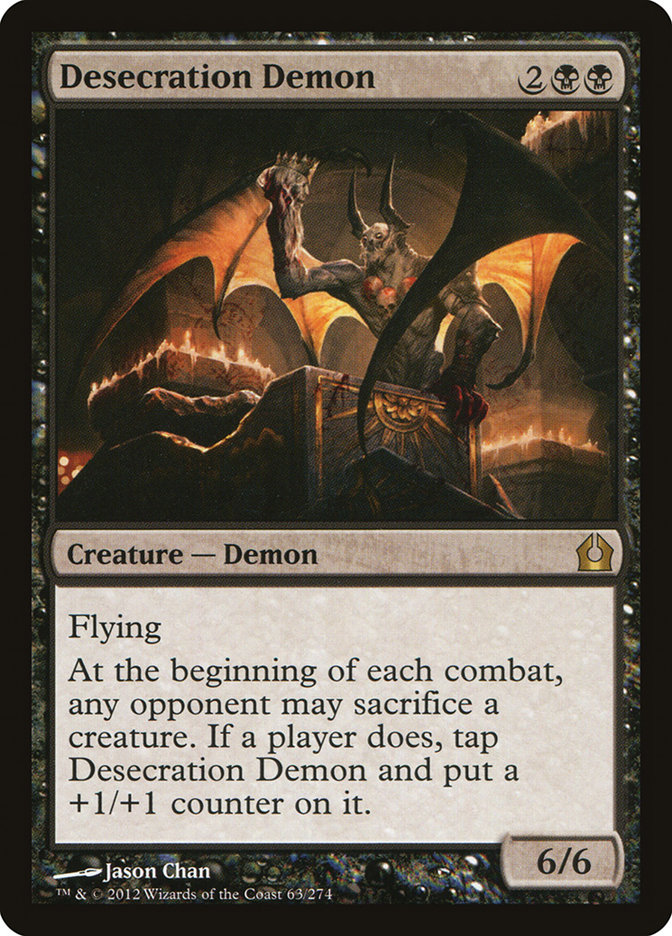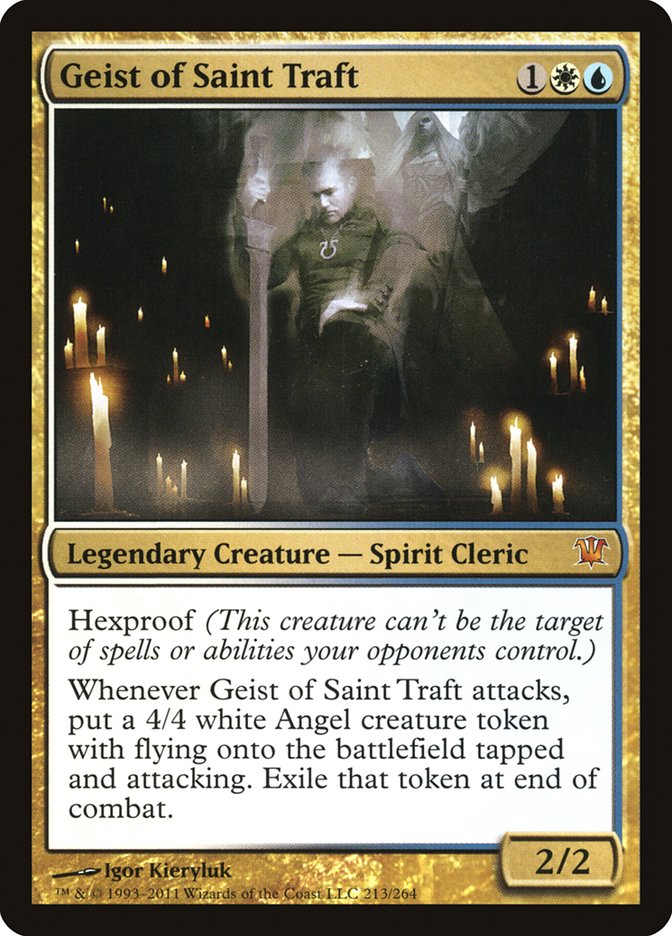What do these cards have in common?

If you said, “Holy crap, I better kill those or else they’ll kill me,” you are correct.
Magic’s been going in a weird direction. I don’t mean weird in a bad way. Just… different. Power versus synergy has been a long-standing debate, but like
most things in Magic, whichever is correct depends on a lot of things. Recently power seems to have overtaken synergy as the best default strategy though.
Don’t believe me?
Compare this deck:
Creatures (15)
Lands (22)
Spells (23)

To this deck:
Creatures (21)
- 4 Phantasmal Bear
- 4 Lord of the Unreal
- 4 Phantasmal Image
- 1 Stitched Drake
- 4 Snapcaster Mage
- 4 Delver of Secrets
Lands (20)
Spells (19)
Sideboard

I don’t think anyone can argue that Delver was the stronger deck overall. The reasons for that are many, but the biggest reason is that Delver outright cut
the cards that were mediocre on their own, allowing it to ride one threat to victory.
The real takeaway here is this:
If you are trying to kill people with creatures, consider playing threats that are capable of winning games in a few turns on their own rather than a swath of threats that seldom do any good on their own.
Yes, Phantasmal Bear into Lord of the Unreal is nice, but by playing those cards, you are pigeon-holing yourself into taking an aggressive stance. You need
those types of openings to make your deck work, whereas a deck like U/W Delver is able to play a more well-rounded game. When you play turn 1 Delver of
Secrets, turn 2 Delver of Secrets and Ponder, you will put games away quickly, but that isn’t entirely necessary.
Delver was capable of playing many roles. The best build changed week to week to adapt to new threats. Since Delver was an aggro-control deck at its core,
it adapted to threats by changing the ways that it attacked people. After all, the “threats” that Delver was concerned about were the ways that people were
trying to fight your deck, not necessarily the threats your opponent would present in game.
Decks like Delver don’t adapt in ways that a U/W Control deck might adapt. U/W might swap Azorius Charm for Last Breath, add another color to upgrade those
Last Breaths into Ultimate Prices, or get a little feisty and play a maindeck Negate. Delver had cards like Dismember and Vapor Snag that were generally
good against most decks and altered the rest of the deck to not run head first into something like Slagstorm.
For example, once everyone had Shatters, the equipment plus Invisible Stalker plan was no longer viable. Once people had Plummets and Crushing Vines, Hero
of Bladehold subbed in for Restoration Angel. At the very last tournament of the format, everyone was on Birthing Pod and Zombies to try and beat Delver,
so I played Mirran Crusaders and Spectral Flights maindeck.
All of that worked well.
What about an example that is a little more recent?
Creatures (16)
Lands (25)
Spells (19)

Creatures (28)
- 4 Judge's Familiar
- 4 Frostburn Weird
- 4 Cloudfin Raptor
- 4 Nightveil Specter
- 4 Tidebinder Mage
- 4 Thassa, God of the Sea
- 4 Master of Waves
Planeswalkers (2)
Lands (24)
Spells (6)
Sideboard

Big dumb animals like Tarmogoyf and Desecration Demon appear to line up poorly against removal, and that’s certainly true to a point. However, one of the
best plans of action is to continually deploy threats, daring them to have the answer. If they don’t, they only have a few turns to draw into it.
One of the biggest misconceptions with the black devotion mirrors was that Desecration Demon would simply die to removal, therefore you should side it out.
In reality, Desecration Demon was capable of doing something that no other card in your deck could — take huge chunks out of their life total.
When the matchup involved a battle of attrition, Underworld Connections was king, but you only had so many life points. Assuming you could keep their board
relatively clear, Gray Merchant of Asphodel would do little to help them. Demon was the one card that might be good for six damage and that was often good
enough to let the chip damage from Mutavault beat them, especially taking into consideration their own Thoughtseizes, Underworld Connections, and potential
shock or painlands.
To top it off, there were cards like Bile Blight and Abrupt Decay that didn’t kill Desecration Demon. Similarly, Tarmogoyf doesn’t die to Lightning Bolt,
and if it gets sent on a Path to Exile in the early turns, you don’t really mind. Swords to Plowshares doesn’t exist outside of Legacy, so there is a real
chance that your “big, dumb animals” might just dodge their removal by the virtue of being big. If not, oh well. You also have the option of playing things
like Thoughtseize and Vapor Snag to protect your creatures from their removal.
Basically, your creatures will die to removal, but if they don’t, you will probably win very quickly. Compared to something like a Gnarled Scarhide, which
you can let go unchecked for quite a few turns, it’s a risk worth taking. Black devotion decks, despite being full of cards with diminishing returns, such
as Thoughtseize and Underworld Connections, had a robust midgame full of powerful topdecks. If you’re playing a deck that, past turn 5, there’s no card
you’re really happy about drawing, there is probably something wrong.
Mono-Blue Devotion versus Mono-Black Devotion has been the debate of the Standard format. Both decks had a lot of success, but at the end of the format,
who is going to argue against Mono-Black? I would hope the answer is nobody.
This isn’t just applicable to Standard though. We’ve seen this shift hit nearly every format in Magic. What about the deck that’s been the scourge of
Legacy for a while now?
Creatures (12)
Lands (18)
Spells (30)

Remember when people thought this deck was good?
Creatures (22)
- 4 Lord of Atlantis
- 4 Merrow Reejerey
- 4 Silvergill Adept
- 4 Cursecatcher
- 2 Coralhelm Commander
- 4 Master of the Pearl Trident
Lands (20)
Spells (18)

I never understood why people would want to play Merfolk when I got to play decks like BUG or RUG which could do the work of three Merfolk all with one
Tarmogoyf. They are equally weak to a non-conditional removal spell, as Cursecatcher and Silvergill Adept aren’t really bringing the beats without a Lord
of Atlantis to help them out, so why not just play Tarmogoyf?
You get to fill your deck with card selection, interaction, and hate. In return, you become far more flexible than any tribal deck ever could be. All the
“Protect the Queen” deck asks of you is to play some of Magic’s most powerful cards. I think we should oblige them.
Consider this: Merfolk does not get to play with Brainstorm.
I mean, sure, there are Islands and you could play fetchlands, but Merfolk doesn’t have the luxury of sitting back and sculpting its hand in the midgame.
You’d prefer that Brainstorm be another lord at basically any point in the game, which is correct given the configuration of the Merfolk deck and what it’s
trying to accomplish.
I cannot stress the importance of getting to play format-defining cards like Brainstorm, especially with a pile of cards that interact with your opponent.
To me, that seems far more powerful than jamming a tribal creature deck and hoping it gets there.
As for Modern?
Creatures (13)
Planeswalkers (5)
Lands (24)
Spells (18)

Creatures (28)
- 4 Kird Ape
- 4 Tarmogoyf
- 4 Wild Nacatl
- 4 Goblin Guide
- 4 Burning-Tree Emissary
- 4 Experiment One
- 4 Ghor-Clan Rampager
Lands (20)
Spells (12)

There’s a reason why B/G/x is continually on top of Modern while Zoo, the former Level Zero choice for Extended, remains largely unsuccessful. A handful of
Kird Apes will only get you so far. Part of the reason is that B/G is able to leverage the virtual card advantage gained from Tarmogoyf much better than
Zoo decks. Again, that’s mostly because of how versatile the Protect the Queen decks are, especially when compared to something as linear as Naya Zoo.
Part of the reason virtual card advantage is becoming so important is because of the prevalence of Protect the Queen decks. Being able to use a single
Tarmogoyf to hold off their entire army takes a lot of pressure off you to have a great draw to match theirs, especially since Tarmogoyf is so cheap. On
the flip side, I’ve Firespouted or Engineered Explosives-ed away two or three Zoo creatures only to die to their Tarmogoyf when I have stuff like Lightning
Bolt in hand, so the sword cuts both ways.
Desecration Demon was originally a card people were not very excited about, at least for competitive play. Its size was monstrous, but its triggered
ability was often seen as a drawback, especially in a format with Lingering Souls. It only creates virtual card advantage when their boardstate is anemic
and/or when you have a high life total. The trick is to figure out how to use Demon’s ability to your advantage and keep the virtual card advantage dream
alive.
One of the best things about Desecration Demon is that it can entice your opponent into throwing away part of their board presence in the hopes of sneaking
in those last few points of damage. If they sacrifice a creature but you untap and play two removal spells, you’ve basically earned a free card at the
exchange of some life points. Now their board should be under control and Demon will be able to either finish them off or hold them off, whichever works
best for you.
One of the biggest points of contention is whether or not to play Dark Confidant. In order for your Queen to be worth it, it needs to end the game on its
own. Ideally, you would want it to be useful at any stage in the game, which Dark Confidant certainly isn’t. I’m becoming increasingly more suspicious of
Dark Confidant’s place in Modern B/G decks, mostly because it doesn’t actually end the game against a lot of decks in the format, even if you untap with it
several times.
The life loss is a real cost, especially when added up alongside Thoughtseize, fetchlands, and shocklands. Your life total is under attack against most
decks and against the decks where it’s not, you’re trying to use Dark Confidant to draw you into more of the stuff that matters, which doesn’t always work
out.
I tried various creature configurations in black-based devotion strategies. This was the default:
4 Pack Rat
When I wanted Abrupt Decay, I tried a different, more green configuration that started like this:
Lifebane Zombie considerations aside, these are good cards but they don’t give you any reach. Additionally, once my opponent stabilized the board, I had to
do a lot of work to get back into it. Pack Rat made your end game almost unbeatable, and I was desperately missing that aspect of the deck.
I thought Sylvan Caryatid would be what the deck wanted. It was a mana fixer and accelerator but gave me more air than I could handle. I’d be working
Underworld Connections and Courser of Kruphix but would come up short. It felt odd to move away from Caryatid, but I knew it was right.
I tried this:
4 Pack Rat
Nissa, Worldwaker wasn’t released yet, but it wouldn’t have changed my experience much. Pack Rat and Desecration Demon both helped my issues, but I was
still unhappy with the package. My life gain was slow and it was difficult to get out of burn range before they drew a lethal spell. Additionally, Courser
of Kruphix, despite comboing with Underworld Connections, was frequently disappointing. It would hold the fort well but did little in the way of actually
killing my opponent, which was the effect I actually needed.
In the end, I returned to the configuration where all my creatures were threats but had the potential to play defense if necessary. It was that versatility
that I needed. Despite the inherent value, Courser had to go, since it didn’t provide me with what my deck needed.
Even Legacy Elves is moving toward Natural Order over synergy. It seems like every time I see a decklist there is one fewer Nettle Sentinel or Heritage
Druid. Some have even began shaving Glimpse of Nature, and I can’t really blame them. There is more strong-arming than finesse happening in Magic right
now. We are less likely to see a “beautiful game” of Magic being played when people are just dropping haymakers on each other, but I’m learning to live
with it.
Maybe Kibler has been doing it right this entire time.




